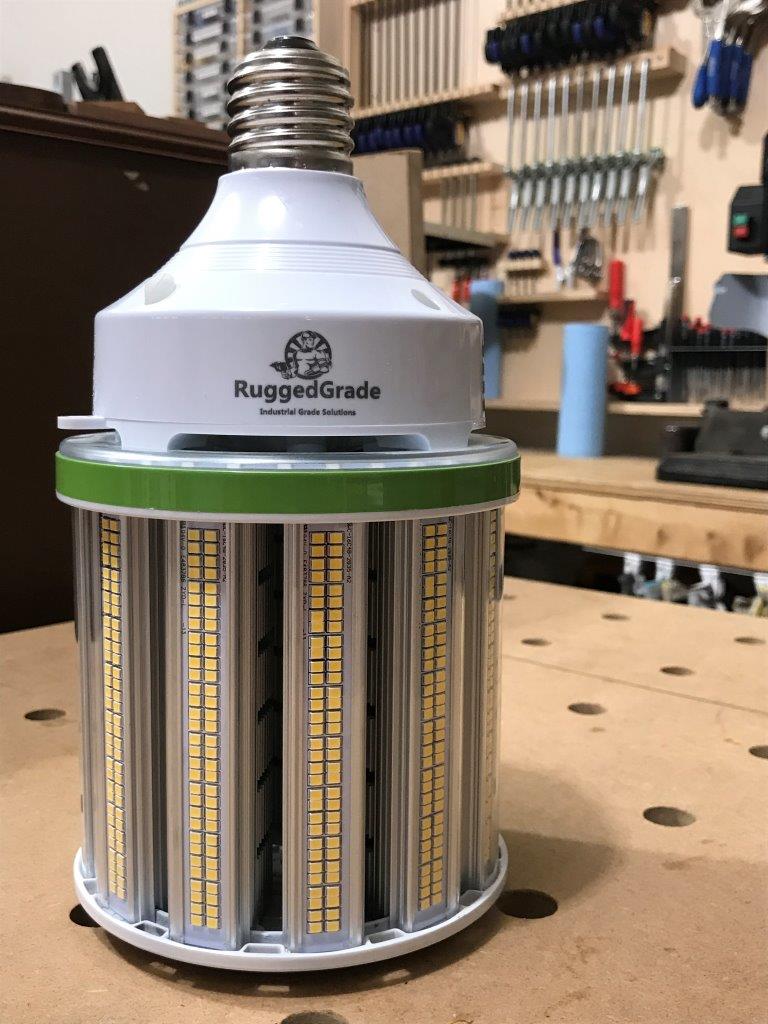Corn Cob LED for Workshop Lighting

A couple of years ago I changed jobs and had to relocate my workshop. If you’ve ever had to do this, you know it requires a lot of time and energy just to restore basic functionality. Power and lighting are essential & my new space was severely lacking in both.
The lighting consisted of three 60-watt equivalent LED bulbs to illuminate a 700 square foot space. For shop work, it was dark, uninspiring, and unsafe. My previous shop was extremely well equipped with several long rows of 8 ft. fluorescent lamps. I missed them greatly, but I wasn’t looking forward to the expense of buying new ones, and the time it would take to install them cleanly onto a finished ceiling…especially in a garage full of moving boxes.
Corn Cob LED to the Rescue
In my search for a better way, I came across some large LED “Corn Cob” lights. Most were marketed towards commercial applications as a replacement for large metal halide lamps in overhead bays. But they came with the advantages of high light output (lumens), energy efficiency, and ease of installation into my existing lamp-holders with no additional fixtures or circuit upgrades required. Fanless versions boasted large heat sinks to dissipate heat and had no moving parts to clog with dust and degrade lifespan.
I tried them and they’ve performed exceptionally well.

Consider Workshop size & layout
As with any lighting, it’s important that you consider the size of the space that you are lighting, available power, ceiling height, any obstructions, etc. In general, these lamps are far bigger than the standard home light bulbs that you may have in place today.
Know your numbers
The key measures of a bulb are Brightness (Lumens), Power (Watts), and Color (Kelvins).
Brightness: A traditional 300-watt incandescent bulb (above) puts out about 3800 lumens. A 60-watt equivalent LED is usually around 800 lumen. Use these familiar references as a scaling factor to estimate how much brightness you’d like to have in your space. There are also plenty of calculators online, but I find it helpful to have my own real-life visual reference.
Power: This is how much energy the bulb uses and has a direct effect on your electric bill. Lower is better, as long as you have the lumens you need. Corn Cob lights are far more efficient than traditional incandescent bulbs. Compared to a 300-watt incandescent, the bulbs I installed put out 4 times the brightness (16,250 lumens), but consume only around 40% of the power (125 watts). This is especially important where the amount of available power may be limited, such as if you must share your equipment and lighting loads together on the same circuit.
Color: This is the yellowness or whiteness of the light. Traditional incandescent “soft white” bulbs have a color temperature of roughly 2700. Bulbs advertised as “daylight” (a very white light) are around 6000. The whiter the light, the higher the temperature. I opted for a balance between the two, choosing a 4000K lamp. For me, it’s a choice I’m very happy with.

In this case, 125 watt, 4000k color temp, 100-277 volts.
Go with fanless Corn Cob LED
Some bulbs use fans that force heat dissipation, allowing for smaller heat sinks and a significantly smaller form factor for the bulb. In a typical garage without woodworking tools, this is likely a good solution. But if you are going to be doing a lot of dust-generating work, this will find its way into the fan and build up over time. When the fan starts to fail, so will your LEDs. Fanless models have oversized heat sinks that dissipate heat through natural convection. You should still clean the bulbs periodically, but there are no moving parts to become clogged or wear out in a workshop corn cob LED.

Aluminum construction to dissipate heat. 
Large aluminum heat sinks throughout.
You may need an adapter
Depending on the size bulb that you purchase you may need an adapter. Higher output bulbs have a “Mogul” screw base, which is a scaled-up version of the traditional “Edison” screw base that is found on typical home light bulbs. These adapters are relatively inexpensive and will hold your bulbs securely in their sockets. The adapter has the smaller “Edison” base, allowing it to be screwed into a standard bulb socket, but it receives the larger “Mogul” base to connect a large Workshop Corn Cob LED bulb.
These adapters can be purchased on Amazon.com. Here are few highly rated examples of what you may need:
Highly Recommended Corn Cob LEDs
Lighting technology is rapidly changing. Costs of these lamps are falling & there are always new manufacturers entering the field. Here are some examples of very highly rated Corn Cob LED technology. I’ve included some with and without fans, so be sure to read the descriptions before buying.


1 Comment
Don · January 24, 2021 at 4:07 pm
Highly informative post without too much detail, this gave me plenty of knowledge to help get me set up with the right bulb choice for my shop.